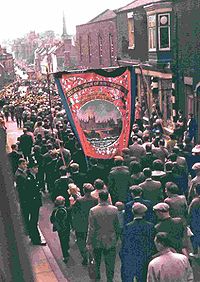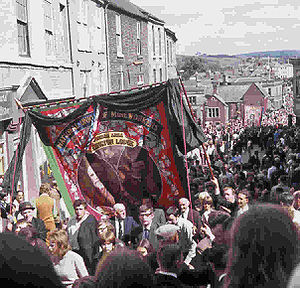
Durham Miners' Gala
Encyclopedia

Durham
Durham is a city in north east England. It is within the County Durham local government district, and is the county town of the larger ceremonial county...
, England
England
England is a country that is part of the United Kingdom. It shares land borders with Scotland to the north and Wales to the west; the Irish Sea is to the north west, the Celtic Sea to the south west, with the North Sea to the east and the English Channel to the south separating it from continental...
. It is associated with the coal mining heritage (and particularly that of miners' trade unionism) of the Durham Coalfield, which stretched throughout the traditional County of Durham. It is also locally called "The Big Meeting" or "Durham Big Meeting". In the context of the Durham Miners' Gala, "gala" is usually pronounced "gayla" rather than the more common pronunciation "garla".
Its highlight consists of banners, each typically accompanied by a brass band
Brass band (British style)
A British-style brass band is a musical ensemble comprising a standardised range of brass and percussion instruments. The modern form of the brass band in the United Kingdom dates back to the 19th century, with a vibrant tradition of competition based around local industry and communities...
, which are marched to the old Racecourse
The Racecourse
The Racecourse is the part of Durham University's sports facilities. It contains squash, tennis and fives courts, cricket, rugby, hockey and football pitches and rowing houses...
, where political speeches are delivered. In the afternoon a Miners' service is held in Durham Cathedral
Durham Cathedral
The Cathedral Church of Christ, Blessed Mary the Virgin and St Cuthbert of Durham is a cathedral in the city of Durham, England, the seat of the Anglican Bishop of Durham. The Bishopric dates from 995, with the present cathedral being founded in AD 1093...
which may include the blessing of any new banners.
History - out of unionism

Durham Miners' Association
The Durham Miners' Association was a trade union in the United Kingdom.The union was founded in 1869 and its membership quickly rose to 4,000, but within a year had fallen back to 2,000...
organised the first Gala, which was held in 1871 in Wharton Park, Durham.
It developed into the largest unofficial miners
Mining
Mining is the extraction of valuable minerals or other geological materials from the earth, from an ore body, vein or seam. The term also includes the removal of soil. Materials recovered by mining include base metals, precious metals, iron, uranium, coal, diamonds, limestone, oil shale, rock...
and trade union gathering in the United Kingdom
United Kingdom
The United Kingdom of Great Britain and Northern IrelandIn the United Kingdom and Dependencies, other languages have been officially recognised as legitimate autochthonous languages under the European Charter for Regional or Minority Languages...
. At its peak the Gala attracted over 300,000 people - over 7 times the population of Durham city itself.
Banners would traditionally be taken on foot from its particular colliery into Durham, and the event was marked by large unions of men marching on the roads leading into the city.
The socialist, and often communist, nature of the miners' unionism found expression in the Gala. In particular, the banners contain several images of notable socialist/communist figures, and captions capture similar sentiments.
The Gala was cancelled from 1915-18 (due to the First World War), 1921, 1922, and 1926 (all due to strikes), and again from 1940-45 due to the Second World War. The effect of the 1984-85 miners' strike
UK miners' strike (1984–1985)
The UK miners' strike was a major industrial action affecting the British coal industry. It was a defining moment in British industrial relations, and its defeat significantly weakened the British trades union movement...
, which saw miners across the Durham Coalfield strike, also led to the Gala being called off in 1984.
The closure of collieries in County Durham, particularly after the Second World War, reduced the numbers attending the Gala. Nonetheless, even if a colliery was closed, the banner was often still marched.
The centenary Gala was held in 1983.
The banners
Most banners represent lodges of the National Union of Mineworkers in the Durham Area. However, other unions have also been represented, particularly in recent years, as well as Union banners from other parts of the UK, including NUM lodges of the Yorkshire branch, and South Wales.They are made of silk, are rectangular, and hang from a cross member, from which guide ropes are held by those carrying it. Traditionally banners were draped in black cloth when there had been a death in the pit during the previous year. More recently following the closure of pits across the county they are draped with black cloth on significant anniversaries of disasters at the colliery they represent.
Many banners contain explicit socialist or communist references, having renderings of Marx, Lenin, and other prominent figures such as miners' leaders, or politicians. Chopwell
Chopwell
Chopwell is a village in Tyne and Wear, located approximately three miles west of Rowlands Gill and one mile north of Hamsterley.Traditionally an area of coal mining, Chopwell was nicknamed "Little Moscow" because of the strong support for the Communist Party...
, often referred to as "Little Moscow
Little Moscow
Little Moscow was a term used to describe towns and villages in capitalist societies whose population appeared to hold extreme left-wing political values or communist views...
", has the only banner (the 1955 version) that contains images of both Marx and Lenin (as well as the hammer and sickle
Hammer and sickle
The hammer and sickle is a part of communist symbolism and its usage indicates an association with Communism, a Communist party, or a Communist state. It features a hammer and a sickle overlapping each other. The two tools are symbols of the industrial proletariat and the peasantry; placing them...
). The 1935 Chopwell banner toured the Soviet Union
Soviet Union
The Soviet Union , officially the Union of Soviet Socialist Republics , was a constitutionally socialist state that existed in Eurasia between 1922 and 1991....
and is thought to reside somewhere in Moscow today. Socialist expressions also take the form of captions - for example, "Socialism through evolution" and "Need before greed" (on Blackhall Lodge's banner).
Christian
Christian
A Christian is a person who adheres to Christianity, an Abrahamic, monotheistic religion based on the life and teachings of Jesus of Nazareth as recorded in the Canonical gospels and the letters of the New Testament...
themes having a socialist resonance also figure on some banners.
More recently, residents in former pit villages have taken it upon themselves to restore, or even create, banners. This has involved the reintegration of collieries that had left the Gala. Some banners, such as Spennymoor
Spennymoor
Spennymoor is a town in County Durham, England. It stands above the Wear Valley approximately seven miles south of Durham. The town was founded over 160 years ago...
's, represent a group of former local collieries rather than individual ones. These have received funding from the Heritage Lottery Fund
Heritage Lottery Fund
The Heritage Lottery Fund is a fund established in the United Kingdom under the National Lottery etc. Act 1993. The Fund opened for applications in 1994. It uses money raised through the National Lottery to transform and sustain the UK’s heritage...
.
Gala today
No deep mines remain in the Durham Coalfield, down from the over hundred that were present at the coalfield's peak. Despite this, the Gala continues to be organised.The 122nd Gala, held in 2006, attracted over 50,000 people, and approximately 100,000 attended in 2009, making it one of the biggest political gatherings in Europe. During the morning banners are still marched to the racecourse with its tradition of speeches (recent notable speakers have included Tony Benn
Tony Benn
Anthony Neil Wedgwood "Tony" Benn, PC is a British Labour Party politician and a former MP and Cabinet Minister.His successful campaign to renounce his hereditary peerage was instrumental in the creation of the Peerage Act 1963...
, Billy Bragg
Billy Bragg
Stephen William Bragg , better known as Billy Bragg, is an English alternative rock musician and left-wing activist. His music blends elements of folk music, punk rock and protest songs, and his lyrics mostly deal with political or romantic themes...
and Ken Livingstone
Ken Livingstone
Kenneth Robert "Ken" Livingstone is an English politician who is currently a member of the centrist to centre-left Labour Party...
) then in the afternoon to the cathedral.
External links
- Durham Mining Museum
- Photographs of 1970s Miner's Banners by Peter Loud
Videos
- Spennymoor banner in 2006
- Bowburn banner in 2007
- A slideshow tribute to the colleries of County Durham, including Dawdon, Murton, Seaham and Sunderland pits: http://uk.youtube.com/watch?v=3uGJhVayK4A
- Durham Miners' Gala 2009
- NASUWT banner in 2010
- Durham Miners' Gala July 2011

